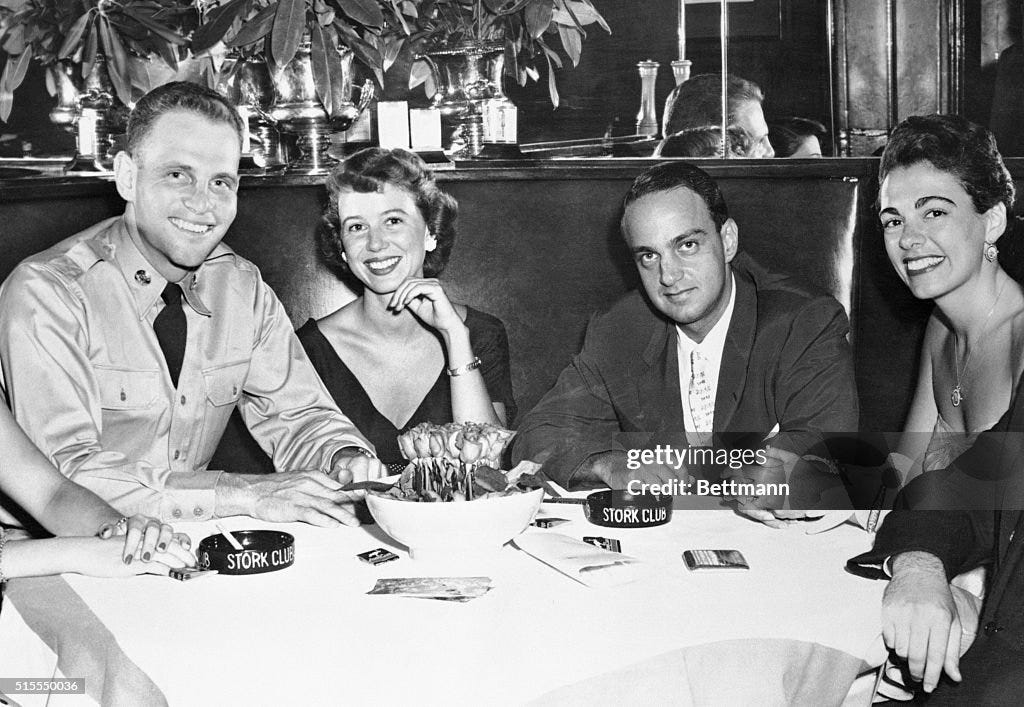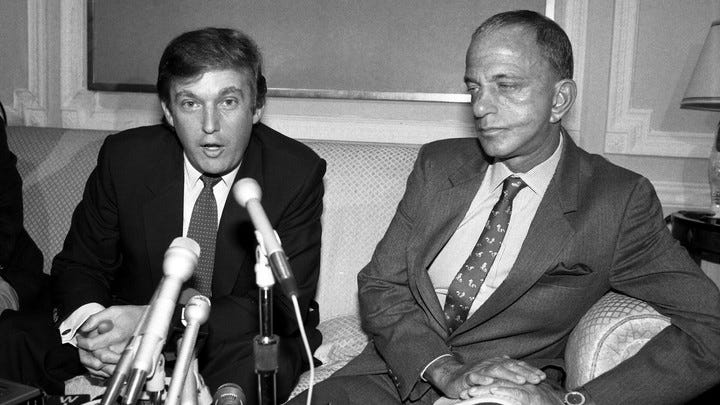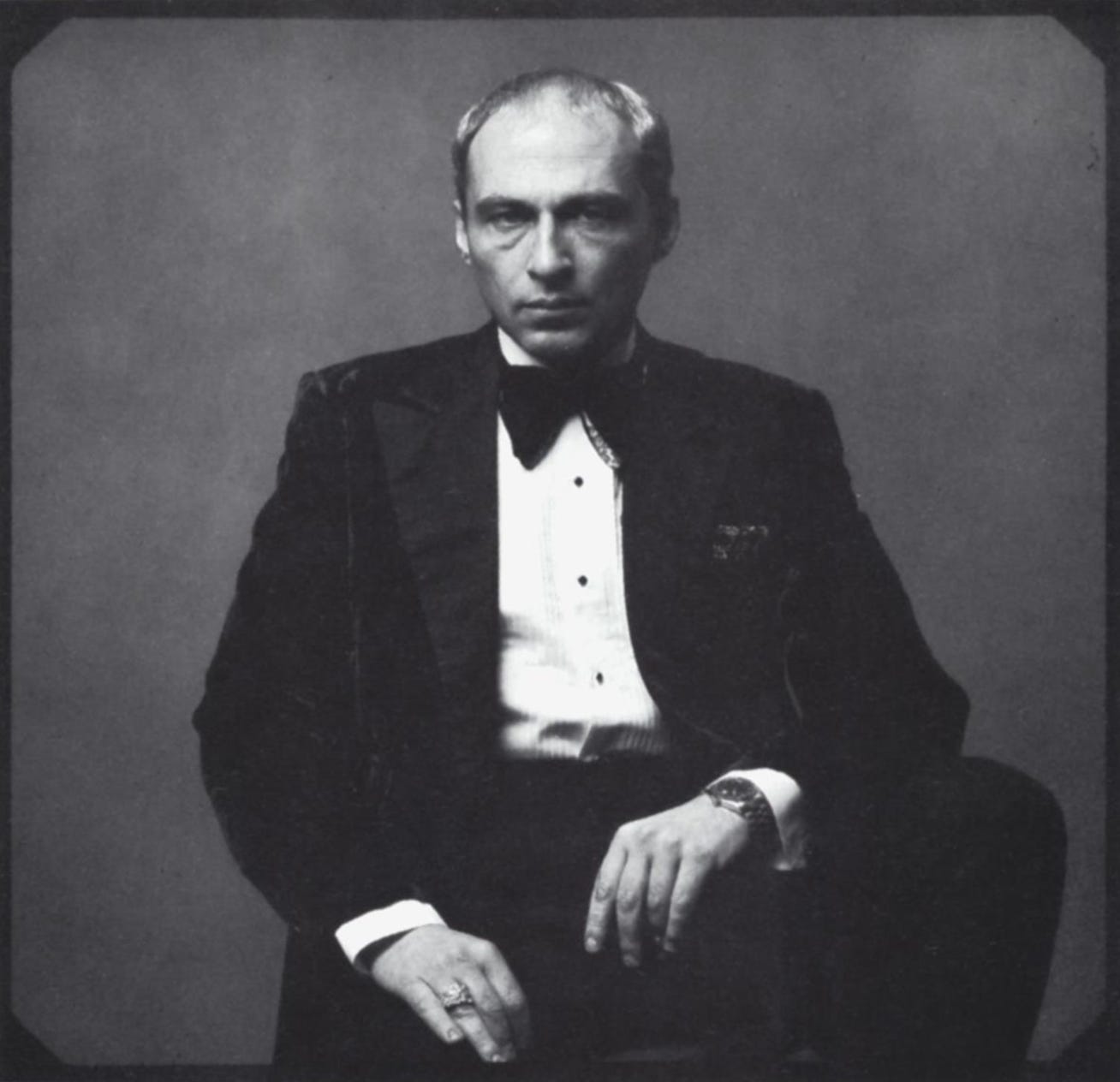This post is too long to appear in full in your inbox. I don’t know where it will cut off in the email version, but it will be available online. See you there!!!
This August marks many things: another Democratic National Convention being held in Chicago while surrounded by protests, the worst Mercury retrograde me and the people in my life have presumably ever seen, and the rise in the use of words like “demure,” “cutesy,” “dingle-dingle,” and “girl,” with the last one being delivered in a very specific cadence.
It is also, most importantly for this piece, the 38th anniversary of Roy Cohn’s death.
In many regards, this piece is overdue. I’ve been threatening it since the inception of Emily For President, though I’ve generally been threatening to talk about Roy ad nauseam since April 2018. For those who have not been subjected to All of This for years, I spent two years researching and writing my college thesis on Roy. Because I can’t let anything go, I have also spent the four years since then researching and writing about Roy.
I should say, before this piece goes any further, that I have and always will actively hate Roy Cohn. Every terrible thing that has ever been said about him is true: he was aggressively cruel and vile and had such a lack of concern for others that is inordinately concerning in and of itself. When I say, “I love Roy Cohn,” I love the version of him that lives in my head.
Over the past six years, I have found enough accounts that have built, to me, a more robust version of Roy that existed in the same body as the villain in our history books—stories from his boyfriends and men he solicited for sex; a minor confession from G. David Schine to Ron Leibman as the latter was researching to play Roy on Broadway; an interview with the Washington Post seven months before his death. Uncovering these small tidbits and coupling them with the historical record has been an ongoing practice of empathy for me in which I constantly force myself to remember that there was a full person inside every anecdote about Roy, one who was neither as evil nor redeemable as a singular narrative can reveal.
In fairness, I don’t know if I can extrapolate this exercise onto every person—I don’t know every person the way I know Roy Cohn.1 But studying him has been, and I hope will always continue to be, really fucking weird and really fucking fun. It has also been remarkably illuminating while navigating a world in which Donald Trump somehow has power—a very enviable skill, to be sure.
Today, I want to do a couple of things. First, I want to put my voice on the record before the internet gets invested in Roy Lore following the upcoming release of The Apprentice (featuring Jeremy Strong’s inevitable star turn playing Roy).2 Second, and perhaps more importantly, I want to share my favorite stories about Roy as proof that history is dramatic, bizarre, deeply personal, and just so much more fascinating than we grow up believing it to be.
On Looking For Evidence Where There Isn’t Any
On January 2, 2021, then-President Donald Trump called Georgia’s secretary of state Brad Raffensperger, and asked him “‘to find 11,780 votes, which is one more than we have’” (X). Four days later, he encouraged a mob of his supporters to storm the Capitol Building where Congress was meeting to certify the results of the 2020 Election in which Trump had lost.
To those aligned with Trump, these seemed like noble and necessary actions to take to “stop the steal” of the election by Joe Biden and the Democrats. To everyone else, it seemed like desperate and harmful attempts to prove a false narrative.
In April 1953, towards the end of Senator Joseph McCarthy’s brief bought of fame as the country’s most outspoken anti-Communist, his legal counsel Roy Cohn and “chief consultant” G. David Schine went on a tour of Europe. The trip was ostensibly to check in on American embassies and International Information Administration libraries to make sure there was no Communist literature available and that the American diplomats were doing their best to promote their country’s dominance over Communism.
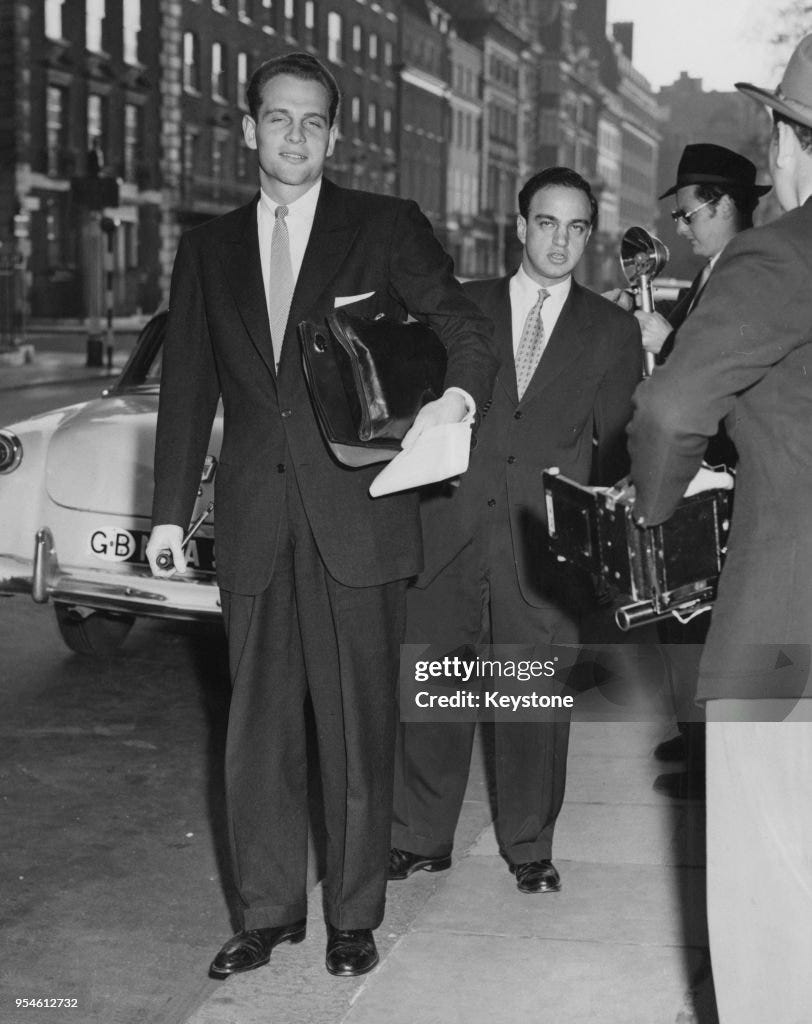
After a time, it turned out to be about books in I.I.A. libraries, but the interest in books was probably minor at the start. The expedition had been set up only a few days in advance, and the purpose of it was so obscure that everywhere the travelers touched down they gave a different account of why they were traveling. In Paris, they said they were looking for inefficiency in government offices overseas. In Bonn, they said they were looking for subversives. Asked in Munich which it was, Cohn explained that it was both. "Efficiency," he said, "includes complete political reliability. If anyone is interested in the Communists, then he cannot be efficient." Back home, on "Meet the Press," he said he didn't consider himself competent to judge performances abroad and had gone only to look into "certain things" (X).
Much like Trump calling Georgia officials to ask for things that didn’t exist, Cohn and Schine’s jaunt largely consisted of the two asking for books, periodicals, and other evidence of Communist infiltration that simply wasn’t there. In a 1986 Letter to the Editor published in the New York Times two weeks after Cohn’s death, a retired Foreign Service official named Hans Tuch recounted the following:
I was the America House (U.S. Cultural Center) director in Frankfurt and, because of geography, became the initial target of the Cohn-Schine anti-Communist crusade in Europe…Mr. Cohn and Mr. Schine arrived shortly after lunch, followed by a gaggle of reporters, creating a commotion in the normally subdued reading-room atmosphere of the cultural center. Mr. Cohn immediately asked where I had hidden the Communist authors in the library. I replied that, to the best of my knowledge, there were no Communist authors in the library. He then asked where I kept the Dashiell Hammett books. I led him to the shelf where ''The Maltese Falcon'' and ''The Thin Man'' were. He turned to the reporters and announced triumphantly that this was proof that there were indeed Communists represented in the American library.
We proceeded to the periodicals section, and Mr. Cohn asked where the anti-Communist magazines were. I pointed out those that I considered anti-Communist, showing him the Jesuit periodical America, Business Week and others, including Time and Newsweek. He dismissed Time by saying that the magazine was a swear word to him. He asked, did we have the American Legion Monthly? When I said no, he countered that we obviously didn't have any anti-Communist magazines.
If you’re wondering what the end goal of finding any such evidence was, that’s a really great question to which there is no answer. As Richard Rovere explained in his biography on Senator McCarthy, “They had no purpose [for the trip] beyond McCarthy's continuing one of free-style, catch-as-catch-can harassment. For this the trip was unnecessary; its victories could have been enjoyed without any traveling at all” (X).
I like this story for two reasons: one, because it is incredibly nonsensical. Why were they actually there? Who was it really for? Did everyone in the 1950s know America had libraries in other countries? Do we still have libraries in other countries?3 The second reason why I like it is because it is a great stepping stone towards my argument that the famous Army-McCarthy Hearings only took place because Roy Cohn had a crush on a boy.
If I’m being honest, I don’t remember learning about the Hearings before college. Whether that was because it was lumped into the larger teachings on the Second Red Scare or because it was never talked about with me the way I’m talking about it with you all now, it was always just a moment in history when American Rationalism and Order Triumphed Over a Fear-Mongerer on a Power Trip. Very exceptionalist, very cutesy.
In actuality, the Hearings were the first brick thrown at Roy Cohn’s sexuality, taking place almost exactly a year after Cohn and Schine got back from their Wet n’ Wild Spring Break Extravaganza. Whereas a largely paranoid American public respected Cohn and Schine for their “efforts,” the people who actually had to deal with the two saw through their schtick and regularly mocked the pair to their faces or in the press. More to it, there was speculation about what was really taking place behind closed doors.
When interviewed for the 1992 book, The Chairman, it came to light that
John J. McCloy, the High Commissioner…from 1949 to 1952, had brought along an associate, his old Wall Street crony Benjamin Buttenweiser. He told McCloy’s biographer, Kai Bird, that while Cohn and Schine were in Bonn, [the United States High Commissioner’s office] bugged their hotel room, revealing eveidence of homosexual conduct, or what Buttenweiser euphemistically called “pillow fights…” (X).
Following their return to the US, Cohn and Schine “were known to jet set around with one another, often flying to Washington for the work week and back to Manhattan to party on the weekends” (X). While Cohn had managed to dodge the draft, Schine was a private in the US Army and was clearly getting preferential treatment, allowing him to regularly leave his station at Fort Dix. To spell it out for you: there allegedly exists an unsigned memo on the letterhead of Assistant Secretary of Defense Fred Seaton documenting testimony from Schine’s chauffeur that Schine and Cohn “‘engaged in homosexual acts in the back of the car’” on some of these excursions (X).
But in 1954, it became clear that Schine would be called to report for training at Camp Gordon in Georgia for five months with no special permissions. This sent Cohn into a bitch fit as “90 percent of inductees were given overseas duty after training” (X). When asked what would happen if Schine were sent overseas without him, Cohn reportedly said, “We’ll wreck the Army…The Army will be ruined…if you pull a dirty, lousy, stinking, filthy, shitty double cross like that” (X).
From there, as the story goes, the US Army formally accused the McCarthy team of “improperly pressuring” the Army on Schine’s behalf, McCarthy said they were just mad at his team for investigating whether or not they had Communists in their ranks, and the Army-McCarthy Hearings began.
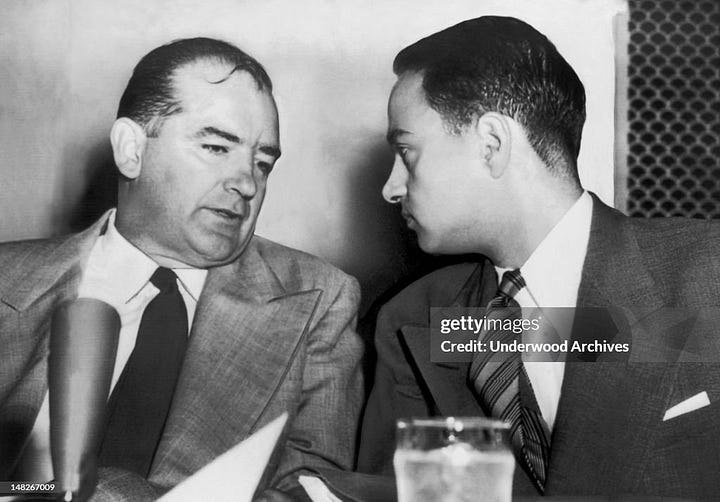
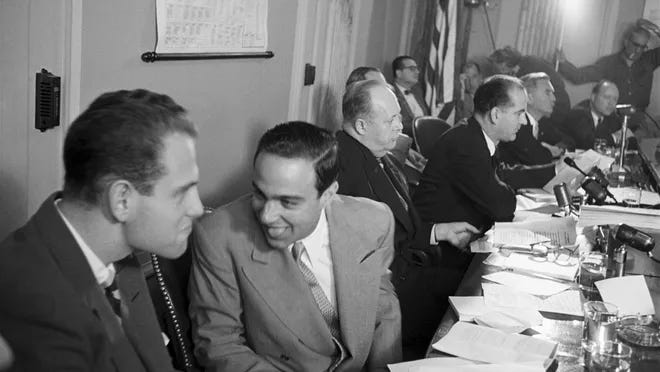
Ironically—or perhaps not—the Hearings were the first time any reference to queerness was made on television. Ever. “The first time the word ‘homosexual’ was said on American TV...happened during the televised Army-McCarthy hearings of 1954.”4
It’s moments and facts like these that are hard to reconcile with Cohn’s impact via the Lavender Scare which saw at least 10,000 government employees lose their jobs as a result of his conflating queerness with Communism. Or maybe it makes sense—in the World According to Roy, the rules applied to everyone else and never him. If that sounds familiar, it’s because it’s the first thing he ever taught Donald Trump.
When Donald Met Roy
If I may, as Emily Sharp explained in the third chapter of her project, Roy Cohn’s America,
in 1973, the U.S. Department of Justice sued the New York-based real estate company, Trump Management for discriminating against Black individuals applying to live in their properties. The DOJ alleged that the organization—namely its CEO, Fred Trump, as well as his son and the organization’s president, Donald—violated the Fair Housing Act by requiring that a “C” be placed on all applications submitted by potential tenants of color to subsequently reject them. The younger Trump was unwilling to admit to wrongdoing even when all of the company’s lawyers told him he had no defense against the charges.
Everyone in Manhattan in the 1970s, including Donald Trump, knew of Roy Cohn and his reputation for ruthlessness so when the two met at the exclusive Le Club, Trump immediately began asking for legal advice. In response, Cohn told Trump that the company should tell the DOJ to go to hell and take them to court over the case. Trump hired Cohn immediately.
From then on, Cohn took Trump in under his wing and “the pair became so close that Cohn referred to the young real estate developer as his best friend and the two talked on the phone a reported 15-20 times a day” (X). They went on to do horrible things together, like bully Ivana Trump, influence judicial appointments, and host the tackiest fucking parties.
Cohn instilled his ethos in Trump from the second they met. His strategy consisted of three steps: “1. Never settle, never surrender. 2. Counter-attack, counter-sue immediately. 3. No matter what happens, no matter how deeply into the muck you get, claim victory and never admit defeat” (X). Of course, the two did settle pretty much every case they brought together, including the DOJ case; “however, they labeled it a success simply because they did not have to admit guilt” after filing a counter-suit alleging the department defamed Trump and his organization (X).
If you watch footage of Cohn before listening to Trump speak for any duration of time, you start to pick up on certain shared phrases, mannerisms, and behaviors. According to
Steve Brill, a New York City-based lawyer who had been active during Cohn’s reign in the city and who defended against the president in the recent Trump University case, recalls how “sometime during the 2016 presidential campaign, [he] noticed that Donald Trump was using Cohn’s exact phrases. ‘I began to hear, If you want to know the truth, and that I can tell you . . . and to be absolutely frank—a sign that the Big Lie was coming’” (X).
In 2016, Cohn’s last boyfriend, Peter Fraser, told the New York Times, “‘I hear Roy in the things he says quite clearly…’ Fraser, who as Mr. Cohn’s lover for the last two years of his life spent a great deal of time with Mr. Trump. ‘That bravado, and if you say it aggressively and loudly enough, it’s the truth—that’s the way Roy used to operate to a degree, and Donald was certainly his apprentice.’”
More to it, Trump’s incessant reliance on loyalty oaths stems directly from Cohn’s own paranoia: “At some point during his time as McCarthy’s chief counsel, ‘an oath of loyalty to Cohn was signed by the staff of the McCarthy Subcommittee.’”5
It’s a bit like that Borat quote: I get a loyalty oath, he must get a loyalty oath (Trump fired then-FBI Director James Comey for not pledging loyalty directly to him); I have get out of jail free card, he must have get out of jail free card (Cohn spent the 1960s in court after being indicted three times but was not found liable in any case); I learn lesson, he does not (Cohn died after being disbarred and owing $7 million in back taxes to the IRS with a legacy as one of the worst people who ever lived. As one of Cohn’s documentarians put it, ”‘The open question...is whether Trump’s luck will hold up or whether—like Cohn—he’ll run out of road…’”)
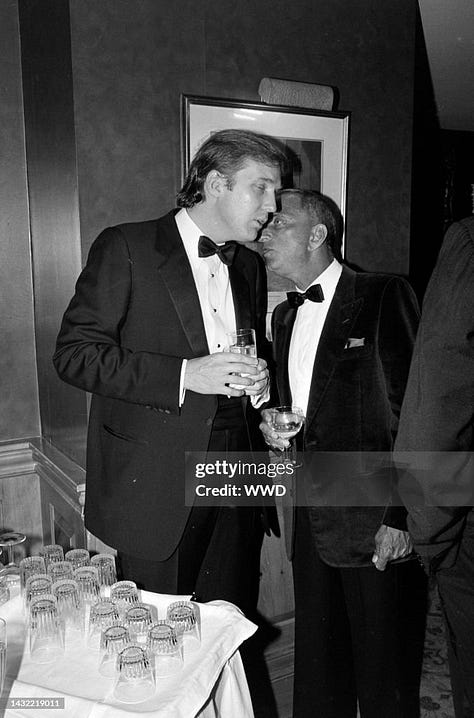
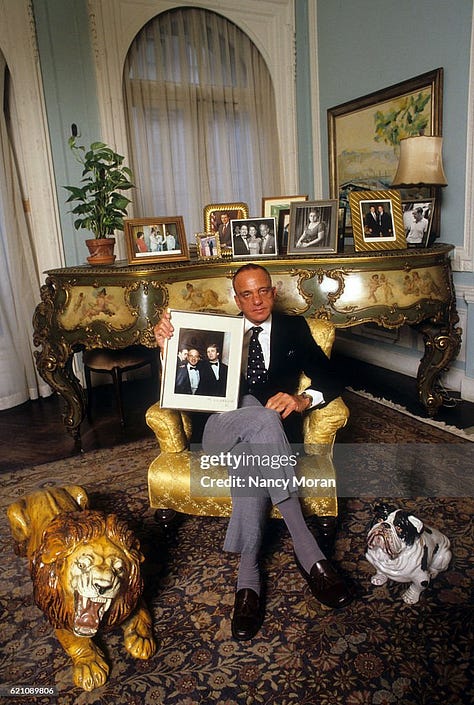
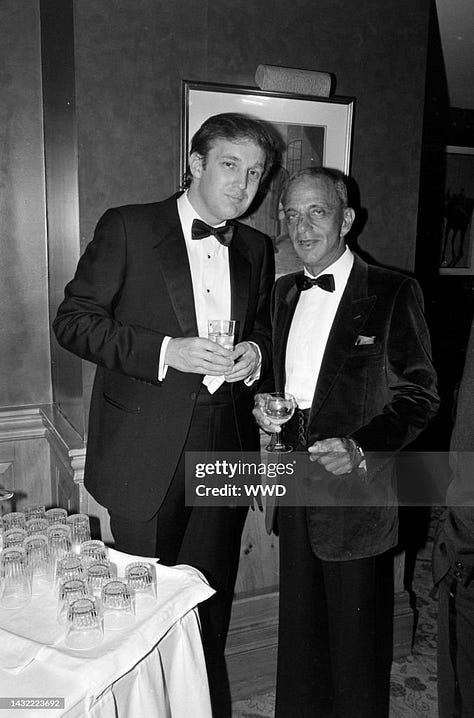
I can wax on about the relationship between Cohn and Trump, and I have, but for the sake of today’s piece, I want to summarize things with a passage from The Art of the Deal…if I had to read it, you do too. Trump asks readers to
just compare [Cohn] with all the hundreds of “respectable” guys who make careers out of boasting about their uncompromising integrity but have absolutely no loyalty. They think only about what’s best for them and don’t think twice about stabbing a friend in the back if the friend becomes a problem. What I liked most about Roy Cohn was that he would do just the opposite. Roy was the sort of guy who’d be there at your hospital bed, long after everyone else had bailed out, literally standing by you to the death.
As I explained in my project,
what could have been a warm recollection of an otherwise reviled figure is soured by the fact that Donald Trump “abandoned his lawyer when he found out that Cohn was HIV-positive... ‘As soon as he found out, he took all his cases away from Roy except for one and got new lawyers. After all they’d been through together.’” In 1986, Trump testified as a character witness on Cohn’s behalf during the lawyer’s disbarment hearings and hosted a grandiose party at the Mar- a-Lago resort celebrating Cohn’s life, but the relationship the two once had was gone…
Journalist Wayne Barrett reported that at Cohn’s funeral, Trump “stood in the back of the room silently, not asked to be one of the several designated speakers, precisely because those closest to Cohn felt he had abandoned the man who had molded him” (X).
I constantly return back to Marie Brenner’s 2017 article in Vanity Fair which charts the relationship between Cohn and Trump so thoroughly. Over the past six years, I have found myself able to understand Trump’s erratic and “unprecedented” behavior because it’s not really his. Cohn didn’t just take Trump under his wing to gain a best friend; he fashioned the former president in his horrifying image and stuck us all with him when he died.
In Memoriam
To complete my program, I had to enroll in a graduate-level course during my senior year. I want to emphasize the had to so we’re clear that this is not a flex. I was very scared!!! And intimidated!!! And also, again, scared!!! My thesis had started to feel too big, too daunting by the fall of 2019, and I was nervous people were finally going to get hip to the fact that I wasn’t an academic so much as I was just a big reader and also a bit weird.
I took a memory studies course and immediately shit bricks. The readings were dense and complicated, and it felt unnecessarily tedious to complete critical analyses of them in our mandatory responses twice a week. So I didn’t. After a couple of weeks of feeling like a flop, I started to write short stories instead of dissections, combining the readings for the class with the readings I was already doing as part of my research.
I say all this because, save for those first two weeks, I spent the rest of the semester building a project of weird little stories that all sought to answer the question, “Who is Roy Cohn to those who remember him?” I wrote about Roger Stone’s receding hairline and efforts to discredit Geraldine Ferraro; I wrote about Barbara Walters and why I imagine she let Roy use her as his beard; I wrote about the ghosts who visited Roy on his deathbed; and I wrote about myself.
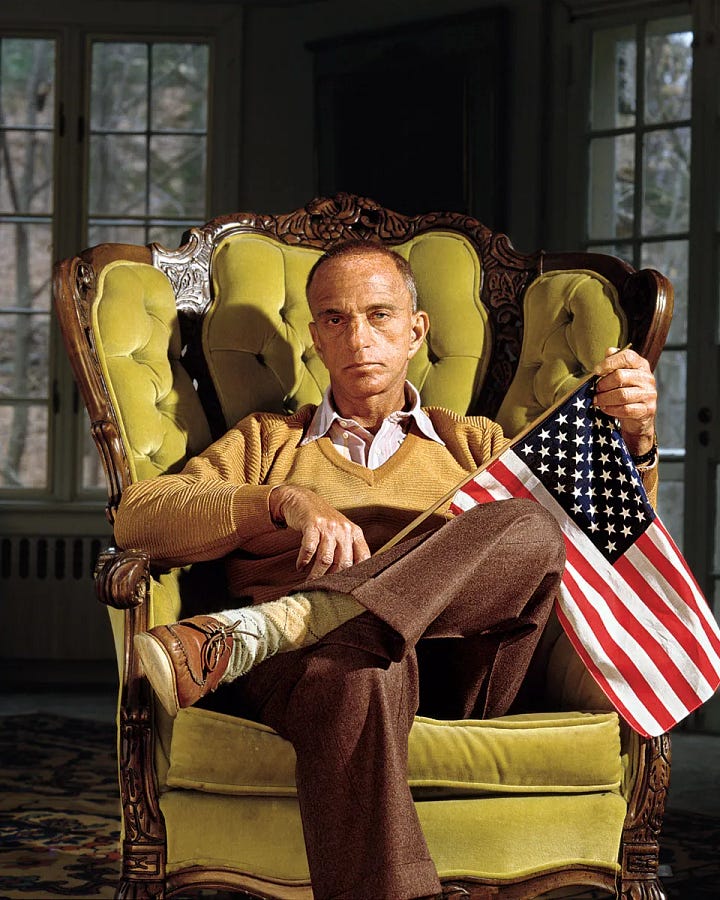
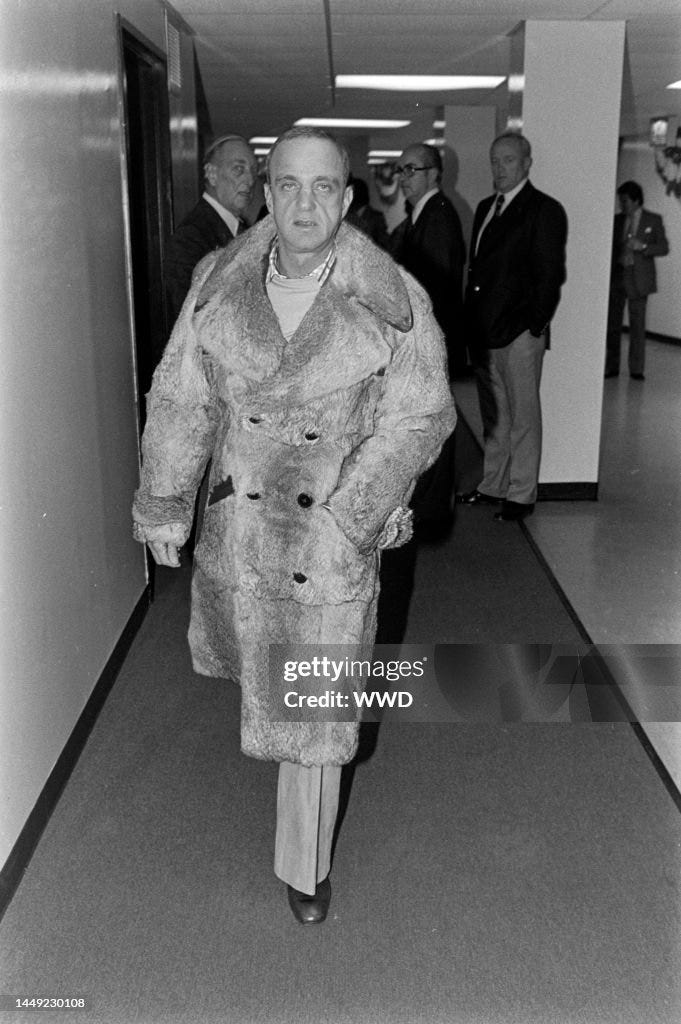
I think a lot about how Roy Cohn is remembered as a result of this project, and I think the best way to encapsulate all of my thoughts on him and to close out this piece is by telling a story about someone else.
Ron Vawter was an avant-garde actor who performed with The Wooster Group and had roles in movies like Philadelphia and sex, lies, and videotape. He died of a heart attack on an airplane in 1994 as a complication of AIDS. In 1992, he received acclaim for his two-act one-man play called Roy Cohn/Jack Smith—each act was a monologue Vawter delivered as the two respective men.
For the Roy Cohn section, Vawter had a dinner jacket made by Roy’s tailor and he wore it to perform a fictionalized version of a speech Roy actually gave.6 In a 1992 interview, Vawter stated “‘Roy Cohn was a first-class louse. I’ve got friends whose lives have been damaged by the way he chose to be, and I don’t forgive him.’” Yet, when Vawter died four months after his play closed, he was buried in the dinner jacket.
Theater historian Stephen J. Bottoms argued that “[Vawter’s] decision to have himself buried in the suit...seemed like a tongue-in-cheek invitation to his mourners to grieve for Roy as well as himself” (X). To go even further, Vawter’s decision forced Roy’s legacy to be inextricably tied to a part of himself he spent his entire life denying.
If I had more time or space today, I would tell you about all of the things Roy’s legacy is tied to: he was the lawyer for the Studio 54 guys when they were indicted for tax evasion; he defended both mob bosses and the Archbishop of New York; he mentored Roger Stone and worked for Richard Nixon and Ronald Reagan long before he worked for Donald Trump. He brought his boyfriend to public events at the Reagan White House!!! The canonically homophobic Reagan White House!!!
So many developments and things that define our political environment today can be traced back to one singular man. I say that not as a celebration of who Roy Cohn was or the legacies he left behind but as the focal point of my argument that history is not an easily confinable thing. It is expansive with tendrils to boot; it is not just dates or sites on a map or names you have to highlight to remember.
This piece stressed me out because I feel like there is so much context I didn’t touch on that I need to. But I think that stress in and of itself just proves my point. There’s always more history to learn and always another figure to use as a means of getting to it.
I ended the acknowledgments of my thesis with the line, “Last but not least, I’d like to thank Roy himself. I met him at the weirdest time in my life and in trying to tell his story, I’ve begun to tell my own. He was a terrible human being but to this day, he remains my favorite (sorry, Mom and Dad).”
Fun fact: the movie is only slated for international release. As of June this year, there was only one US studio even interested in releasing the movie following pressure from the Trump campaign and Trump himself, and it has not yet been confirmed if the studio finalized the distribution deal. That said, it will be released in the UK and Ireland this October.
It’s not 100% clear because a lot of bureaucratic terms changed in a short period of time, but it’s my understanding that the agency responsible for establishing and running such libraries was abolished in 1999.
The article this was directly pulled from appears to no longer have a link but there is proof of it on the journalist’s MuckRack.
Source: New York Law Society, “Roy Cohn Fact Sheet,” box 89, folder 50, pg. 6, National Lawyers Guild Records, Tamiment Library and Robert F. Wagner Labor Archives at New York University.
The transcript of the real speech, given in 1978 at a dinner for the American Society for the Protection of the Family, has never been found.





